Veronica Rasmusen
This article explores the gender dynamics of interruption strategies in the context of podcasts. Podcasts are becoming more and more popular every day, and as they are beginning to hold more influence in media, it is important to analyze how traditional gender roles and gender hierarchies are reflected in the conversations that are the heart of podcasts. Through the examination of same-gender and cross-gender conversations from two podcasts, The Joe Rogan Experience and Unlocking Us With Brené Brown, patterns in interruption strategies across gender and interview roles became clear. After counting and categorizing all interruptions made by each individual in conversation, this study found that men used all three interruption types more often than women in alignment with a dominance perspective to interruption. However, on closer examination of specific conversational gender compositions and role pairings, interruption strategies become more complicated and nuanced.
What do we know about interruptions and gender?
Interruptions have been well-researched by the linguistics community, however there is no clear consensus in the literature on whether there are any gender differences. In Zimmerman & West (1996), they found that in cross-sex conversations, almost all interruptions were made by male speakers rather than female speakers. Marche & Peterson (1993) found in their examination of 20-minute conversations of various young age groups that there were no interactions with interruptions and gender.
This mixed literature led some researchers to study interruptions in specific contexts in order to get a better picture of how interruption strategies function in conversation. In a study investigating the specific context of Supreme Court justices, female justices were interrupted more during arguments (Feldman & Gill, 2019). In another study with specific context, comparing interviews of Hillary and Bill Clinton, Hillary was interrupted more via overlap while Bill Clinton was interrupted more times successfully. As seen through these studies, when analyzing interruptions in very specific contexts, subtle nuances of interruption strategies between genders are revealed.
Why study interruptions in podcasts?
From these findings, there is a clear need for interruption research to be conducted in specific contexts in order to determine what situations make individuals more likely to interrupt or more at risk at being interrupted. One context where interruptions have not been researched are podcasts. Podcasts are becoming increasingly popular, increasing its audience by 43 million weekly listeners from 2013 to 2019 (Koetsier, 2020). Two extremely popular podcasts are The Joe Rogan Experience and Unlocking Us With Brené Brown. These podcasts follow a casual conversational interview format with permanent hosts and new guests each episode. Since it is possible that interruptions are more related to interview roles than gender in this context, interview role was analyzed in this study as well.
Men’s language can be analyzed through a dominance-based approach that is manifested in response to male desire for power, status, and control (Aries 1996, as cited in Feldman & Gill, 2019). This may lead men to use interruptions more often in order to dominate conversation. Women may have a more supportive language approach that is responsive and concerned about social connection, reflective of gender asymmetries (Mulac 1989, as cited in Feldman & Gill, 2019). Using a dominance-based approach to analyze interruption, this study examined how interruption strategies are used differently by individuals of different genders and interview roles during informal podcast interviews to assert societal power or appease others according to the gender hierarchy.
How were interruptions studied using podcasts?
Unlocking Us with Brené Brown and The Joe Rogan Experience were chosen since they both feature solo hosts of similar age, have freeform conversational interview formats, and are on top podcast charts. This study examined two random podcast episodes from each host on Spotify, one with a male guest and one with a female guest. For Unlocking Us with Brené Brown, episodes with Emmanuel Acho and Melinda Gates were chosen and For The Joe Rogan Experience, guests Fahim Anwar and Tulsi Gabbard were picked.
Each interruption in the first ten minutes of conversation was counted and categorized by the following: cooperative, competitive or backchanneling. Interruptions were counted as any instance where an individual began speaking before the current speaker had finished their turn, creating overlap of speech. Competitive interruptions were counted as when an individual stopped the current speaker’s turn by changing the subject, disagreeing with a statement, or answering a question prematurely. Cooperative interruptions were classified as when the interruptor asked the current speaker to repeat or explain something, agreed with a statement, or helped to finish the current speaker’s sentence, and then allowed for the interrupted speaker to continue after. Backchanneling interruptions were counted as when the interruptor interjected with a one word “yeah”, “uh-huh”, “mhmm”, “right”, or “okay” without ending the current speaker’s turn.
What were the results?
The amount and type of interruptions made by each individual in each conversation examined is summarized in Figure 1.
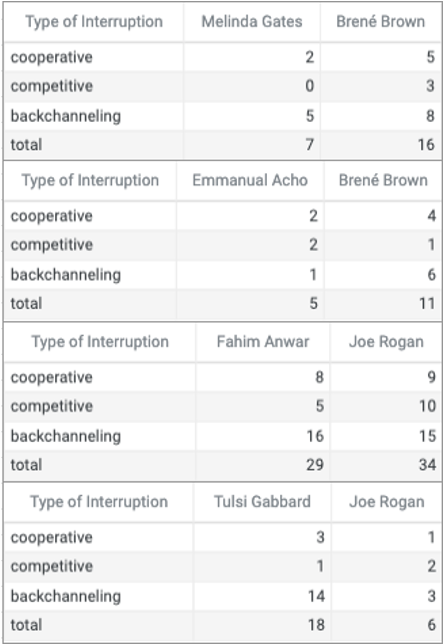
The data was broken down into 4 categories by role and gender: hosts, guests, women, and men as shown below in Figure 2.
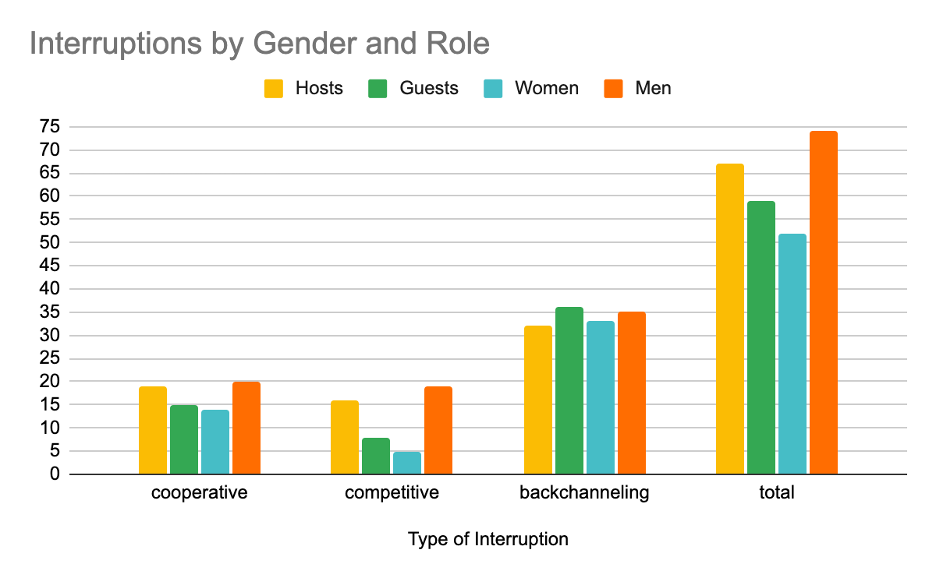
What do these results mean?
The patterns in this analysis indicate that people utilize different interruption strategies based on gender and role during conversational interviews, and that these interruption strategies are related to the gender hierarchy and traditional gender roles. Men were hypothesized to interrupt in all situations more often than women. This was confirmed by the results which indicated that men interrupted 74 times compared to 52 times by women. This could be explained by gender hierarchies which may make men feel they have more right to conversational floor and have the power to violate polite turn-taking convention, confirming the dominance model. In addition, gender had a larger correlation with interruption strategy overall than interview role.
Against predictions, women did not backchannel more often than men, however this was the only interruption type where men and women showed similar levels of interruption. It is of interest to note that men backchanneled the most when speaking to other men. This can be seen in Joe Rogan and Fahim Anwar’s conversation about dancing in Example 1, specifically lines 5 and 12.
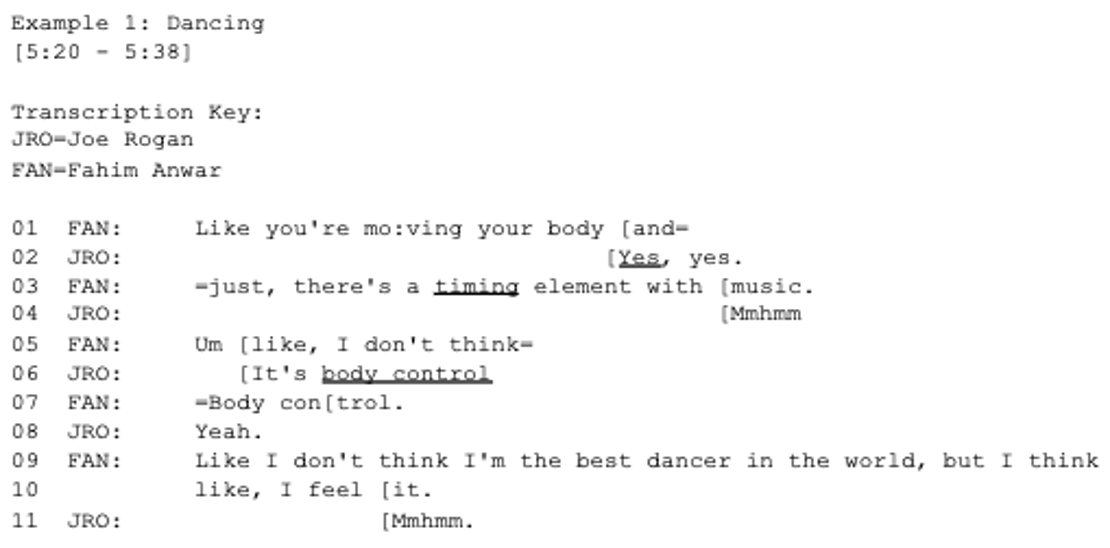
When speaking to Tulsi Gabbard, Joe Rogan only used backchanneling 3 times, compared to 15 times with Fahim. This could indicate a societal understanding that two men have equal status and therefore both deserve to show each other they are actively following their conversation, in contrast to speaking with a woman who may have perceived lower status and does not “deserve” the politeness.
Hosts did use more cooperative and competitive interruptions than guests, however there was one interaction where the guest did make more competitive interruptions. For the female host-male guest interaction, Emmanuel Acho made more competitive interruptions than Brené Brown, one such interruption shown in example 2, where they talk about Emmanuel’s strict upbringing.
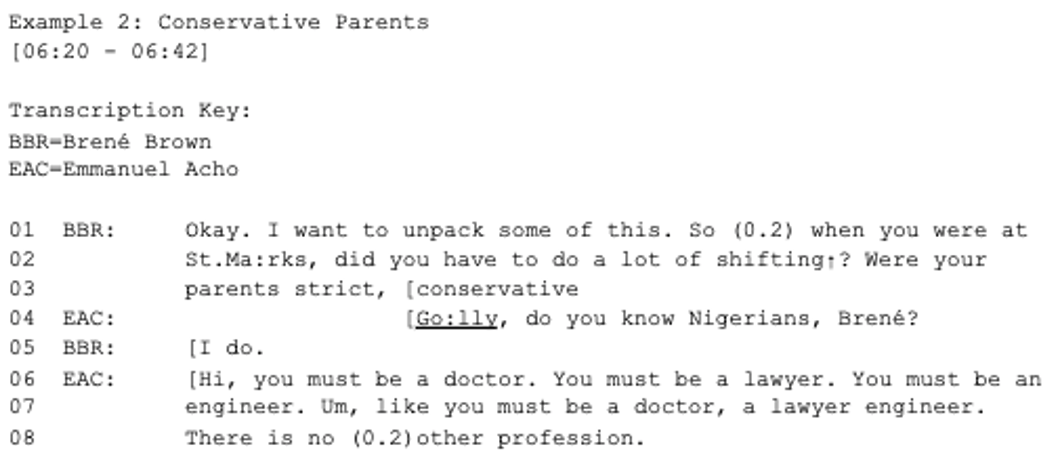
Emmanuel first interrupts Brené by asking her another question before she asks her question to him in line 4. Again, he does not allow Brené to fully answer before he continues speaking in line 6. Competitive interruptions are more hostile than cooperative interruptions, so the fact that a male guest, who should be in a lower power position than a host, exercised his power to take over a turn, shows that gender is a more important determinant than role in this context. This could possibly be due to the power imbalance and role-gender power mis-match in this pairing.
Concluding Thoughts
This analysis provides more research on the topic of interruptions in dyadic informal interview conversations with same-gender and cross-gender interactions, using podcasts as a context. Men used all interruption types more than women and hosts made more cooperative and competitive interruptions than guests. There were some special cases, such as male-male conversations that showed men backchannel most when speaking to women and male-guest and female-host interactions in which there were deviations from the pattern. The results indicate that a pattern does exist with respect to gender and role in informal podcast conversations that reflects traditional gender norms and the societal patriarchy. Interruption strategies do vary by gender and role during informal podcast interviews. Negative interruptions impede an individual’s ability to speak or share their opinion, as well as reinforce the gender hierarchy through speech, thus it is important to determine what situations individuals may be at risk of increased interruptions based on their gender. Future directions should continue to study interruptions in more contexts to broaden our understanding of how interruptions are used in different situations by different people.
Notation Scheme
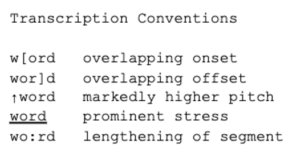
What to Read Next:
Researchers Identify Nine Types of Human Interruptions in Conversations
Linguistic science has revealed a stunning truth about a chaotic debate
Exploring what an interruption is in conversation | Stanford News
References
Almoaily, M. (2020). Impact of age and gender on frequency of interruption in dyadic interviews. Interaction Studies, 21(2), 187-199.
Eckert, P., & McConnell-Ginet, S. (2013). Language and Gender. Cambridge University Press.
Feldman, A., & Gill, R. D. (2019). Power dynamics in supreme court oral arguments: The relationship between gender and justice-to-justice interruptions. Justice System Journal, 40(3), 173-195.
James, D., & Clarke, S. (1993). Women, men, and interruptions. Gender and conversational interaction, 231-280.
Koetsier, J. (2020, May 21). Joe Rogan Takes $100 Million To Move Podcast To Spotify, Drops Apple, YouTube. Retrieved from https://www.forbes.com/sites/johnkoetsier/2020/05/19/joe-rogan-moves-podcast-with-286-million-fans-to-spotify-drops-apple-youtube-other-platforms/?sh=7ecebf3a2a23
Marche, T. A., & Peterson, C. (1993). The Development and Sex‐Related Use of Interruption Behavior. Human communication research, 19(3), 388-408.
Sacks, H., Schegloff, E. A., & Jefferson, G. (1974). A simplest systematics for the organization of turn‐taking in conversation. Language, 50, 696 – 735. doi: 10.17323/1728-192X-2015-1-142-202
Suleiman, C., & O’Connell, D. C. (2008). Gender differences in the media interviews of Bill and Hillary Clinton. Journal of psycholinguistic research, 37(1), 33-48.
Yang, L. C. (1996). Interruptions and intonation. In Proceeding of Fourth International Conference on Spoken Language Processing. ICSLP’96 (Vol. 3, pp. 1872-1875). IEEE.
Zimmermann, D. H., & West, C. (1996). Sex roles, interruptions and silences in conversation. AMSTERDAM STUDIES IN THE THEORY AND HISTORY OF LINGUISTIC SCIENCE SERIES 4, 211-236.